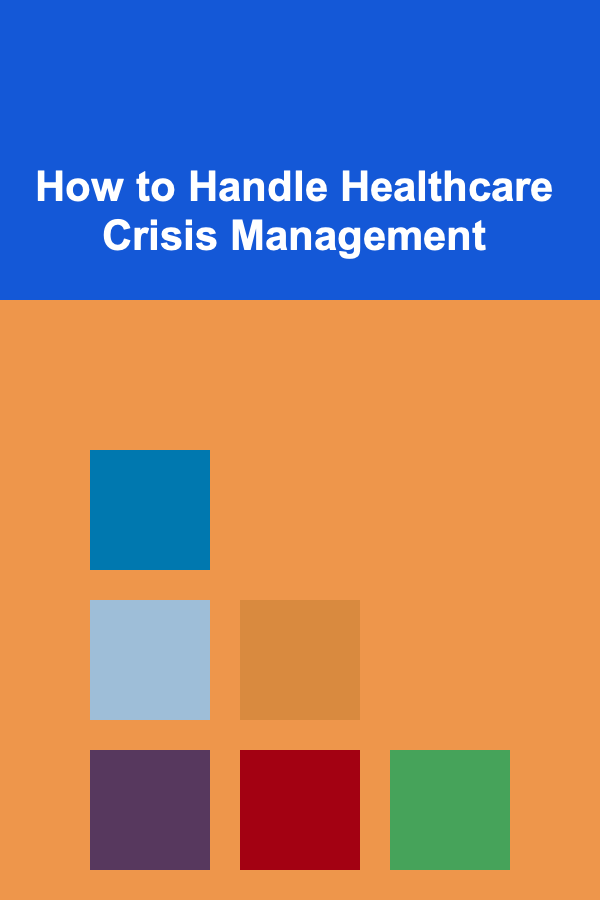
How to Handle Healthcare Crisis Management
ebook include PDF & Audio bundle (Micro Guide)
$12.99$5.99
Limited Time Offer! Order within the next:

Healthcare crises are complex and demanding situations that require quick thinking, strategic planning, and effective execution to minimize damage, protect lives, and restore normal operations. From natural disasters and pandemics to mass casualty incidents and public health emergencies, healthcare crisis management is a vital skill for healthcare professionals, administrators, and policymakers. The ability to handle such crises effectively can make the difference between life and death, as well as ensure that health systems remain functional under extreme pressure.
In this comprehensive guide, we will explore the best practices, frameworks, and strategies involved in managing healthcare crises. We will break down the steps that healthcare leaders and teams can take to prepare for, respond to, and recover from these critical situations.
What is Healthcare Crisis Management?
Healthcare crisis management involves the coordination, leadership, and systematic actions taken to address a situation that threatens the normal operation of healthcare systems. It encompasses both the preparedness for potential crises and the response to unexpected events that disrupt the healthcare infrastructure.
A healthcare crisis can take many forms, including:
- Natural Disasters: Earthquakes, floods, hurricanes, and wildfires that overwhelm local healthcare facilities.
- Pandemics and Infectious Disease Outbreaks: Widespread illness, such as the COVID-19 pandemic, which strains healthcare resources.
- Mass Casualty Incidents: Events such as terrorist attacks, transportation accidents, or industrial accidents that result in a large number of injured or deceased individuals.
- Resource Shortages: Issues like medicine shortages, medical equipment failure, or staff shortages that impact healthcare delivery.
- Technological Failures: Cyberattacks or system failures that disable healthcare services or compromise patient data.
Healthcare crisis management ensures that, in the face of such disasters, the health system continues to function and serves the public efficiently while minimizing harm.
Importance of Healthcare Crisis Management
The significance of effective healthcare crisis management cannot be overstated. During a crisis, healthcare systems are stretched beyond their limits. Inadequate preparation or poor crisis response can lead to the following:
- Loss of Life: Inadequate or delayed treatment can lead to unnecessary deaths.
- Public Panic: Lack of clear communication can exacerbate public fear, leading to chaotic situations.
- Resource Mismanagement: Improper allocation of resources can result in shortages, where life-saving equipment or medicine is unavailable.
- Healthcare Worker Burnout: A poorly managed crisis can lead to exhaustion and mental health struggles among frontline healthcare workers.
Proper crisis management provides structure and direction, allowing healthcare providers to make informed decisions, prioritize resources, and deliver care effectively, ensuring the best possible outcomes.
Phases of Healthcare Crisis Management
Crisis management in healthcare generally follows a cyclical process that includes four main phases: Preparedness, Response, Recovery, and Mitigation. These phases are interrelated, and preparation in the early stages is critical to ensuring a swift and effective response.
1. Preparedness
Preparedness is the proactive phase of crisis management. It involves anticipating potential crises, planning for various scenarios, and ensuring that healthcare systems have the resources, protocols, and training necessary to respond effectively.
Key Components of Preparedness:
- Risk Assessment: The first step is identifying potential threats that could impact the healthcare system, such as infectious disease outbreaks, natural disasters, or mass casualty events. A thorough risk assessment helps prioritize the most likely or most damaging crises, allowing for focused preparedness efforts.
- Emergency Plans and Protocols: Every healthcare institution should have comprehensive emergency plans in place. These plans should include specific protocols for different types of crises, detailing the roles of staff, resource allocation, and patient care procedures.
- Training and Simulation: Healthcare staff must be trained regularly on crisis response. This includes conducting mock drills and simulations for various disaster scenarios to test the readiness of staff, identify gaps in the plan, and ensure the staff can respond quickly under pressure.
- Communication Systems: An effective crisis communication system is essential. It includes communication with patients, staff, the public, and other stakeholders. Developing clear, accurate, and timely messaging can help manage expectations and prevent confusion during the crisis.
- Resource Management: Preparedness also involves ensuring that necessary resources (e.g., medical supplies, personnel, and equipment) are readily available and can be mobilized during a crisis. Creating stockpiles of essential supplies, such as personal protective equipment (PPE) or life-saving medications, is part of this effort.
- Collaboration and Partnerships: Healthcare systems should establish partnerships with government agencies, non-governmental organizations (NGOs), and other healthcare providers to share resources, expertise, and information during a crisis.
2. Response
The response phase refers to the actions taken once a crisis has occurred. This phase involves mobilizing resources, implementing emergency plans, and delivering immediate care to those affected. The primary focus during the response phase is saving lives and managing the situation to minimize further damage.
Key Components of Response:
- Activation of Emergency Plans: When a crisis occurs, the healthcare institution's emergency plans should be activated. This involves notifying the response team, mobilizing resources, and executing protocols to manage the situation effectively.
- Triage and Patient Care: During mass casualty events or pandemics, healthcare providers must assess and prioritize patients based on the severity of their condition. Triage protocols help ensure that those with the highest chances of survival are treated first.
- Resource Allocation: Efficiently managing resources, including medical staff, equipment, and medication, is crucial in the response phase. This might require making difficult decisions about where and how to allocate limited resources.
- Staff Management: Healthcare workers are at the frontlines during a crisis. Their well-being and safety must be prioritized. Providing adequate PPE, rest periods, and mental health support is essential to maintaining staff effectiveness.
- Public Communication: Clear and timely communication with the public is critical to managing the crisis. This includes providing updates on the situation, outlining health recommendations, and explaining what actions the public can take to protect themselves.
- Collaboration: Coordination between local, state, and federal agencies is crucial for effective crisis management. Partnerships with other healthcare organizations and community leaders can help improve resource distribution and response efficiency.
3. Recovery
The recovery phase focuses on returning to normalcy and rebuilding after a crisis. This phase can take weeks, months, or even years, depending on the nature and scale of the event.
Key Components of Recovery:
- De-escalation of Operations: As the crisis subsides, hospitals and healthcare facilities begin to transition back to routine operations. This involves de-escalating emergency services and focusing on recovering normal patient care processes.
- Mental Health Support: Both patients and healthcare workers need psychological support after a crisis. Healthcare workers, in particular, may experience burnout, trauma, or PTSD. It's important to provide counseling services, peer support, and mental health resources to help staff recover emotionally.
- Restoring Services: In the aftermath of a crisis, hospitals may need to restore damaged facilities, replace depleted supplies, and reinstate services that were disrupted. This includes rebuilding infrastructure and replenishing medical stockpiles.
- Assessment and Review: After the immediate recovery period, healthcare systems should conduct a thorough review of their crisis management efforts. This includes assessing what worked well and identifying areas for improvement. Lessons learned from the crisis can inform future preparedness efforts.
4. Mitigation
Mitigation involves taking steps to reduce the impact of future crises. This phase is about learning from the current crisis and improving systems and processes to prevent or minimize the effects of similar events in the future.
Key Components of Mitigation:
- Implementing Improvements: Based on the lessons learned from the crisis, healthcare systems can implement new policies, improve infrastructure, and refine protocols to reduce vulnerabilities in future crises.
- Strengthening Public Health Systems: Mitigation often involves improving public health systems to enhance their capacity to handle future threats. This may include increasing funding, bolstering emergency response teams, and enhancing surveillance systems for early detection of potential crises.
- Policy Changes: Governments and healthcare institutions may implement policy changes that address systemic weaknesses exposed during the crisis. This could include revising healthcare regulations, investing in healthcare infrastructure, and creating stronger public health frameworks.
Best Practices for Effective Healthcare Crisis Management
To successfully manage healthcare crises, healthcare providers must follow best practices that ensure efficiency, minimize risk, and prioritize patient care. Here are some key best practices:
- Clear Leadership: Strong, decisive leadership is crucial during a crisis. Leaders should be able to communicate effectively with staff, the public, and other stakeholders, providing clear direction and maintaining a calm demeanor.
- Collaborative Decision-Making: While leadership is essential, crisis management should involve input from multiple stakeholders. Collaboration between healthcare providers, emergency responders, and policymakers ensures that decisions are well-rounded and well-informed.
- Real-Time Data: Access to real-time data is critical during a crisis. This includes tracking patient numbers, resource availability, and the spread of infectious diseases. Real-time data allows for more informed decision-making and resource allocation.
- Community Engagement: Engage with the community to understand their needs and provide accurate information. Public health campaigns and community outreach can help mitigate panic and ensure that people take the necessary precautions.
- Flexibility: Healthcare crises are often unpredictable. The ability to adapt to changing circumstances and adjust plans quickly is essential for managing the situation effectively.
Conclusion
Healthcare crisis management is an essential skill for healthcare providers, administrators, and policymakers. The ability to prepare for, respond to, and recover from healthcare crises can make a significant difference in the outcomes of these events. By following a structured approach that involves preparedness, effective response, recovery, and mitigation, healthcare systems can better protect the health and well-being of their communities during times of crisis.
In today's increasingly interconnected and complex world, healthcare systems must be ready for any crisis that may arise. Strong leadership, collaboration, and a commitment to continuous improvement will ensure that healthcare institutions are well-equipped to handle whatever challenges lie ahead. Effective crisis management not only saves lives but also strengthens healthcare systems, making them more resilient in the face of future challenges.
Reading More From Our Other Websites
- [Personal Finance Management 101] How to Develop a Financial Strategy for Early Retirement
- [Home Security 101] How to Keep Your Home Safe During a Power Outage
- [Organization Tip 101] How to Practice Gratitude through Organized Lists
- [Organization Tip 101] How to Organize Your Closet Based on Outfit Types
- [Home Family Activity 101] How to Have a Family 'No Tech' Night for Quality Time
- [Home Lighting 101] How to Achieve Authentic Farmhouse Lighting in a Modern Home Without Sacrificing Style
- [Home Storage Solution 101] How to Make the Most of Closet Doors for Extra Storage
- [Personal Finance Management 101] How to Save for Retirement When You're a Young Family
- [Organization Tip 101] How to Create a Gardening Space That's Easy to Maintain
- [Home Budget Decorating 101] How to Style Your Shelves with Affordable Decor

How to Implement a Checklist for Sales Training Programs
Read More
How to Keep Your Home Allergen-Free and Dust-Free
Read More
How to Manage and Dispose of Expired Products Responsibly
Read More
How to Manage Your Time as a Busy Landlord
Read More
How To Create a Minimalist Living Room
Read More
Mastering Behavioral Interview Questions with the STAR Method
Read MoreOther Products

How to Implement a Checklist for Sales Training Programs
Read More
How to Keep Your Home Allergen-Free and Dust-Free
Read More
How to Manage and Dispose of Expired Products Responsibly
Read More
How to Manage Your Time as a Busy Landlord
Read More
How To Create a Minimalist Living Room
Read More